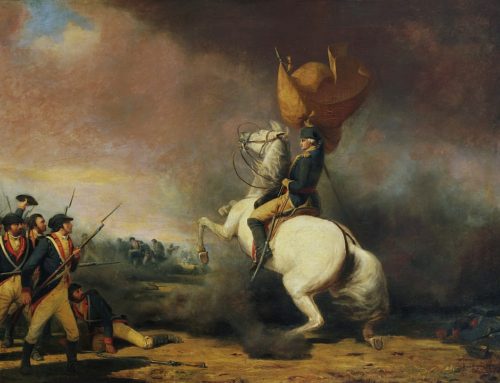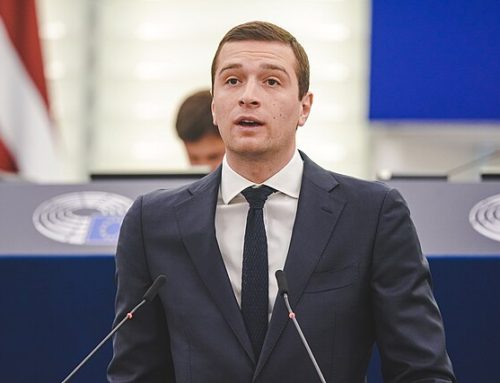“You must understand that Germany will never on its own move to attack Russia… If you provoke the Germans on the border, if you move forces without our permission, then bear in mind that heads will roll.”
— Reported comment of Stalin to his military leaders mid-May 1941
In failing to realize that Hitler worked on intuition rather than hard logic, Stalin made what was probably the most serious mistake of his career. Stalin, himself, operated frequently on whim rather than hard headed analysis. Moreover, Stalin’s preemptory execution of disloyal subordinates totally undermined legitimate weighing of military options.
What was Operation Barbarossa ?
On June 22, 1941, Germany launched a surprise attack on Russia. With that surprise attack, Hitler tore up the endless codicils that marked the non-aggression pact between these behemoth totalitarian states. For six months the Russians suffered unprecedented catastrophes before halting with the help of the cruel winter weather the German onslaught.
Some sixty-five years after the massive German surprise attack on the Soviet Union, June 22, 1941, the failure of Stalin to anticipate Hitler’s surprise attack and his prevention of precautionary measures by the Red Army for a German invasion remain one of history’s great mysteries. Stalin’s stubborn blindness resulted in colossal military setbacks that almost fatally undermined the Soviet Union. Given Stalin’s suspicious nature and his meticulous attention to detail into every aspect of Soviet life, the reasons for his obstinacy and his blindness deserve some attention.
No Good Deed Goes Unpunished
On the eve of the German invasion, a German communist soldier risked his life and crossed over into Russia in order to warn the Soviets of the impending attack. Stalin ordered that the man be summarily executed for fabricating a false alarm.
Stalin twisted well intentioned efforts to warn him of the impending Nazi attack. Stalin irrespective of receiving hundreds of reports of an immanent Nazi attack by his own intelligence network and Western political leaders maintained his irrational belief that a German offensive against the Soviet Union would not begin until 1942. His steadfast focus on 1942 derived largely from his own destructive actions. Specifically, he decimated the Red Army by his massive purges of leading military personnel in 1937-1938. In 1941, Stalin reportedly commented to Khrushchev that the “Nazis would surely blow our heads in.”
Stalin’s obsession with 1942
Stalin’s obsession with 1942 derived from his recognition that the “weakened” condition of the Red Army was directly attributable to his actions. Therefore, Stalin convinced himself that the Nazis would operate on his demented time schedule. Stalin stuck with the 1942 time schedule despite
1) The surprise collapse of French resistance in 1940.
2) The increasing strained relationships between Germany and the Soviet Union over the division of spoils in Greece, Romania, Bulgaria, and Finland.
3) The massive build up of German troops on the Russian border required a “cover.” German explanations that the presence of their increased troops was a ruse to deceive Great Britain seemed threadbare even in 1940. The ability to fool Stalin stemmed from his steadfast believe that the invasion of Russia would only take place after the Nazis’ “knocked Britain out of the war.”
Messages of warning sent by Churchill and Franklin Roosevelt were rebuffed because Stalin was convinced that at a minimum the Western allies wanted to provoke a war between Germany and the Soviet Union in order to dissipate German attacks on Great Britain. In the worst case, Stalin believed that Great Britain and Germany were close to forming an alliance to attack the Soviet Union.
Role of Rudolph Hess
The Bizarre flight to Scotland by Rudolph Hess, the number three person in the Nazi hierarchy, one the eve of the Nazi invasion of Germany remains the source of speculation even today.
To Stalin, Rudolph Hess’s trip to Great Britain could only be explicable in the context of an impending peace negotiation between Great Britain and Germany. The failure of Hess to obtain Hitler’s permission to initiate peace feels with Great Britain has reinforced conventional thinking that Hess was 1) Trying to win back his diminished status in the Nazi hierarchy though a “miraculous breakthrough in the logjam that prevented a negotiated settlement between Great Britain and Germany 2) Hess was lured to Great Britain in order to learn more about the suspected German invasion of the Soviet Union.
Operation Barbarossa
“Soldiers of the eastern front an assembly of strength on a size and scale such as the world has never seen in now complete. The biggest front line in history is launched to save our entire European civilization and culture from the threat of bolshevism.”
—Adolph Hitler’s Decree June 21, 1940
Size of German Invasion
Between the Baltic and Black Sea, the German forces were arranged in three massive army groups, comprising seven armies, four Panzer groups, and three air fleets. Poised on the frontiers were some 3,200,000 men—148 divisions, including nineteen Panzer divisions and twelve motorized fighting vehicles, 7184 artillery pieces and 1830 aircraft. By comparison, the Allied invasion of Normandy on June 6, 1944 landed a first wave of six sea borne divisions and three airborne, a grand total of nine divisions containing some 75,000 British and Canadian troops and 57,000 Americans, along a front of less than fifty miles, as opposed to one of nearly 1,000. In essence, given the size of the German invasion, and the ability of Soviet aircraft to have pinpointed the massive number of German troops poised on the Russian frontier, the lack of defensive preparation on the part of the Red Army was criminal negligence. As stated in the beginning of this essay, the primary culprit was Joseph Stalin who strenuously opposed any meaningful defensive actions on the part of his military personnel. Irrespective of his own culpability, Stalin had several generals on the Western front summarily executed for their “negligence” in preventing the Soviet catastrophe.
The cost to the Soviet Union was enormous and unprecedented. At least twenty million Soviet citizens died, and a further twenty-five million were mutilated or crippled. Out of every one hundred Soviet soldiers who went to the front in 1941, only three survived physically unharmed by the end of World War II.
Examples of the Cost of Stalin’s Paranoia
Within forty-eight hours of the German invasion, 2,000 Russian aircraft had been destroyed most of them on the ground. Many of the Russian planes were pegged down to prevent pilots from either fleeing Stalin’s brutal regime or posing as an armed threat to the regime. For the same reason ammunition was kept under separate control well away from the weapons it was intended for.
Paper Strength of Red Army
On paper, the Soviet Union was militarily stronger than Nazi Germany. The size of the Red Army in June 1941 was 5,373,000 men, armed with over 67,000 field guns and mortars, 1,861 tanks, and over 2,700 combat aircraft. No fewer than 170 divisions with a total strength of 2,680,000 men armed with 37,000 guns and mortars, 14,75 tanks and 1,540 modern combat aircraft were stationed on the western frontier. The failure of the Soviet Union to halt the attack can be blamed on the door of Joseph Stalin, who was blind to the numerous signs of an impending attack. Stalin not only had spies killed who reported the impending invasion, but admonished his commanders not to take any action to encourage German transgression of the non-aggression pact, including reconnaissance missions.
Stalin’s Purges
Moreover, Stalin with his savage purges has all but destroyed the Red Army as an effective fighting force with savage purges during 1937-8. The floodgates were open with the execution of Marshal M.N. Tukhachevsky, the most brilliant commander in the Red Army plus seven leading generals. Stalin accused these men of being traitors who strove to overthrow the soviet government. Roy Medvedev, the pre-eminent Soviet historian, believes that some 400,000- 500,000 political and administrative leaders were shot between 1936-39. The total number of victims was some 4.5 million. These are estimates because accurate figures are not available. Most reliable sources indicated that some 35,000 officers were shot or sent to labor camps. At least half of the five marshals, thirteen out of fifteen army commanders, 220 our of the 406 brigade commanders, seventy –five of the eighty members of the supreme military council, including every single commander of a military district, and all eleven vice-commissars of war were either executed or imprisoned. The remnants of the Army officer corp. were inexperienced, disorganized and completely demoralized. The modernization and mechanization programs were utterly shattered. Therefore, given the wide scale destruction of the Red Army, a realistic time table to rebuild the Soviet military capability would be even later than 1942.
What was Stalin’s Reaction to Barbarossa?
Initially, Stalin seemed to have suffered severe loss of nerves. He initially retreated to his dacha and issued few directives. In fact, Molotov not Stalin addressed the nation about the German attack. The use of Molotov was a dramatic departure from Stalin’s obsessive policy of consolidating “all powerful roles in the Soviet Union” under his direct control, particularly when then need to make speedy decisions outweighed Stalin’s previous emphasis on maintaining the myth that Soviet policy was a collective decision rather than his sole prerogatives.
However, within a fortnight, Stalin seemed to have regained his self confidence. His address to the nation which combined pragmatic guidelines, optimistic forecasts, and patriotic themes reassured the Soviet citizenry. Ultimately, he formulated an effective but costly campaign to slow down the German advance. Moreover, Stalin effectively orchestrated the latent Russian patriotism to save the Motherland into frenetic activity capable of rebuilding their shattered armament capacity, even moving factories in Western Russia to safer areas in the hinterlands. He sought external military alliances with the Western powers, his former antagonists, and reorganized his populace into a total war machine.
Stalin’s Military Role
Once formidable hostilities began, Stalin exerted overall direction of the military effort. His meddling, particularly the use of the secret police to spy on his military commanders, led to some irrational behavior. That is, since Stalin rarely left his dacha, there was a “disconnect” between his military directions and the facts on the ground. However, given his insatiable “lust for blood” nobody was inclined to correct Stalin’s misperceived notions. Franklin Roosevelt and Winston Churchill who operated under democratic guidelines that stressed “division of powers” seemed to have been more effective military leaders. Churchill and Roosevelt were respectively the first among equals as commanders of chief of their armed forced. In their roles, they needed to consult with the military professionals. While the decision making process of the Anglo-Americans was slower than their Soviet counterparts, the quality of their decisions and the consensus build-up by the democracies led to more rational decisions, and an ability to alter plans to fit the contingencies on the ground. Also, on balance, the American and British selection of leaders led to high quality appointments, and rational removals for “failed” commanders. On the other hand, Stalin suffered from a mixed back of both good appointments, and interfering Secret Service Personnel who lacked military training. In the case of Russia, Stalin’s obsession with “divide and conquer” of his military leaders had two negative impacts: 1) It led to poor decision making and 2) poor execution given the divided demand structure.



